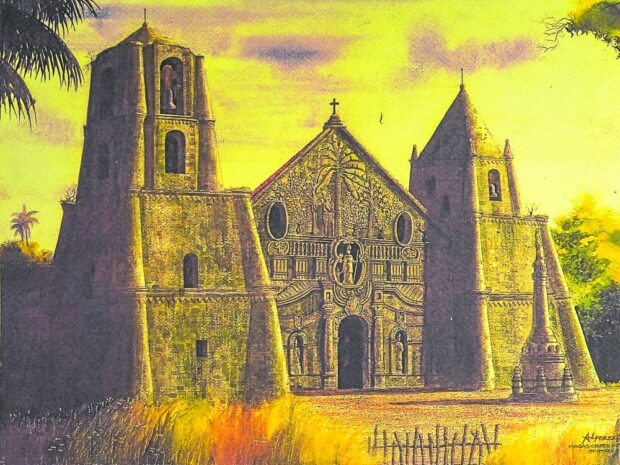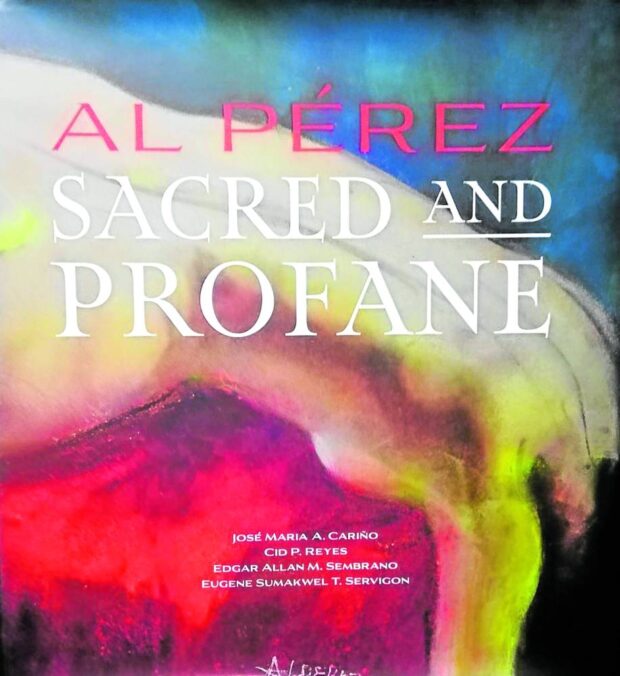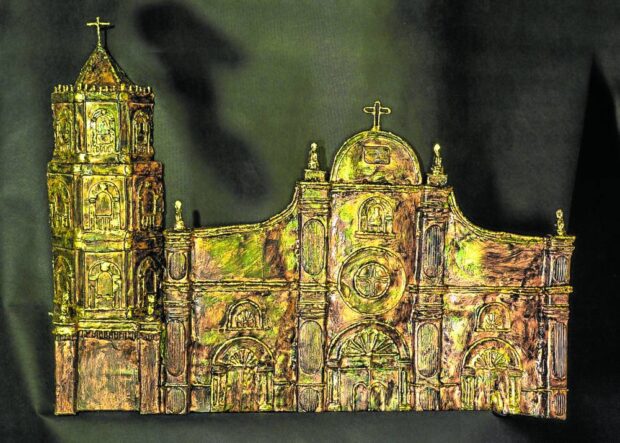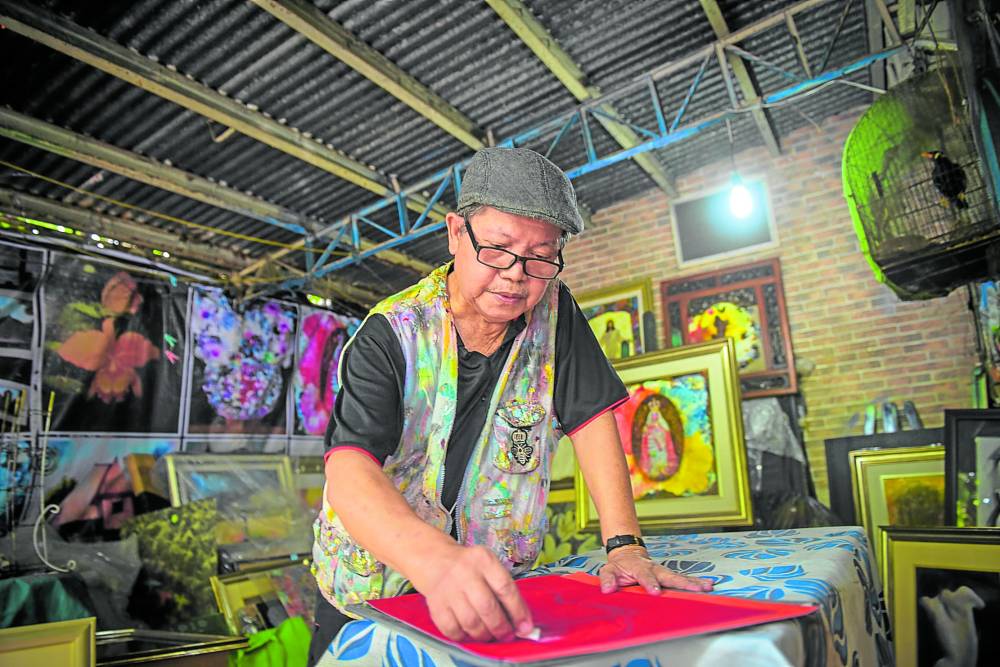Veteran artist Al Pérez, who has memorialized through his art the country’s heritage churches, fittingly gets a coffee-table book memorial and fond tribute all his own through “Sacred and Profane,” published in 2023 by Kawayan Press of the Cebu-based Museo Cariño of Ambassador José Maria A. Cariño.
Edited and coauthored by the envoy himself with top art critic Cid Reyes, cultural journalist Edgar Allan Sembrano and cultural diplomacy researcher-writer Eugene Sumakwel Servigon, the book covers the life and works of Pérez, 76, from the “Sacred” (historic churches) to the “Profane” (nudes), the latter he’s produced prodigiously with, the artist is quick to assure everyone, the blessing of his wife.
It is easy to see why Cariño has supported Pérez’s art all these years. After all, Cariño, who had been stationed for many years in the country’s diplomatic mission in Madrid before becoming ambassador to the Court of Saint James, was the author and publisher of the famous coffee-table book, “Jose Honorato Lozano,” about the Spanish-era artist who pioneered the letras y figuras colonial art genre; it won the National Book Award in 2002. He has written and edited as well other notable books on Philippine history and cultural heritage, most recently a massive coffee-table tome on San Sebastian Church in Manila (which we will review soon).
Cariño’s cultural-heritage advocacy has made him champion the work of Pérez, whom he describes in the book as a “friend to all, enemy to none,” even calling him as one of the “peacemakers” whom Jesus Christ calls “Blessed” in the Sermon on the Mount in Matthew’s Gospel.
Houses of God
“Al Pérez is generally known for his paintings, drawings and sculptures of churches,” Cariño writes. “This obsession for capturing the aesthetics and architecture of these houses of God has brought him all over the country.”
Many of these churches are in various stages of decrepitude or near-collapse. “[Pérez’s] depictions make them more visually vivid from an artistic perspective,” Cariño continues. “Images of crumbling walls and fallen structures also remind us of the need to restore and preserve them for future generations … ”

As for the nudes, Cariño calls them “another object of ‘worship.’” “His female and male nudes are alluring, with compositions, contours and shadows that are mesmerizing,” the retired career diplomat writes. “… Al’s drawings exude a sensual mystery stylistically depicted in celebration of this divine form … ”
Reyes writes that Pérez’s churches aren’t a mere documentation. “[T]he painterly churches of Pérez come across to the contemporary viewer with the weight of centuries, the density of the passage of time and the gravitas of our colonial past, which together in the alchemy of history, created the identity, indeed the soul, of the Filipino.”
Servigon focuses on Hagonoy, the Augustinian-founded Bulacan town where Pérez hails from. “Growing up in a town with rich heritage,” Servigon writes, “Pérez was exposed to art and religious iconography from a young age. “ … Apart from the churches, the landscapes and scenes of Hagonoy are also among the artist’s favorite subjects.”
In his short biography of the artist, Sembrano calls the young Perez a “miracle boy.”
When Pérez was a child, he was suddenly gripped by fever. Distressed since her grandson was having febrile seizures, Cecilia “Anda Elyang” Pérez rushed him to the Santo Cruz visita (or chapel) in Hagonoy, and placed him before the icon of Santa Elena. She asked the mother of the Emperor Constantine, who herself found the True Cross in Jerusalem, to intercede for her so that God would cure her son. She promised that should her grandson survive, he would serve the Church and carry her (St. Helena’s) image during processions.
Pérez was immediately cured. Since then, he has remained faithful to the vow made by his grandmother.
During the annual feast every May 4 of Santa Cruz in Hagonoy (actually, May 4 is the feast of St. Helena), the procession of saints would include the icon of Santa Elena, whose camarero (or gentleman in waiting) is Pérez.
Precocious skills
As camarero, it is Pérez’s task to safe-keep the icon of Santa Elena and design her costumes. Exhibiting early on precocious skills in art and design, Pérez enrolled at the famous fine arts school of the University of Santo Tomas (UST), where he came under the tutelage of Cenon Rivera, who had trained in stained-glass art at the Vertrate d’Arte Giuliani in Rome and who had been commissioned to do stained glass for various churches, notably the Immaculate Conception church (now cathedral) in Pasig. A classmate was Manuel Baldemor from Paete in Laguna, another Tagalog town celebrated, like Hagonoy, for its arts and crafts.

After graduating from UST, Pérez did advertising work (his officemates were Tessie Tomas and Celeste Legaspi); painted giant ad and movie billboards (among them, the Charito Solis starrer “Igorota”); worked for Ayala Museum in its project to document ancient churches around the country, did its dioramas and designed its publications, notably the coffee-table book on Amorsolo by Alfredo Roces; mounted sold-out exhibits for Galerie Bleue of Rustan’s which attracted collectors that included Imelda Marcos and her Blue Ladies; and ran a famous column in the Manila Bulletin (“Philippine Sights and Wonders”).
In 1981, during the first visit of Pope John Paul II, Pérez was commissioned by Tourism Secretary Jose Aspiras to do a painting of the Agoo, La Union, church to be given to the Pontiff. In 2015, he was commissioned to do a portrait of Pope Francis with the Manila Cathedral as background. Both works are now in the Vatican collection.

Pérez became close to the masters; one of them became a very good friend—Jose Joya. In the 1980s and 1990s he had his “nude awakening” and started doing nudes during Saturday group sessions (even famous movie actresses wanted him to paint them nude). All along he was giving art workshops everywhere. In one workshop in Malabon, he discovered a child prodigy—Ronald Ventura.
“At 76,” Sembrano writes, “Al still paints every day until 4 a.m. He is not afraid to reinvent (himself) and discover new things, even imbibing the styles and techniques of young artists. He does his work ‘all for the glory of God.’” —Contributed INQ
To order “Al Pérez: Sacred and Profane,” email [email protected]; call tel. +63917-8234616.









































